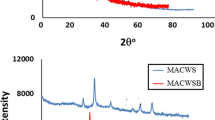Abstract
This study aimed to determine the Pb+2 adsorption capacities of hazelnut shell and activated carbon obtained from hazelnut shell. It also aimed to determine the effect of ZnCl2 in the activation process. The hazelnut was pyrolyzed at 250 and 700 °C. For determining the capture speed of the adsorbents, the pseudo-first- and second-order kinetic studies were performed. The Freundlich and Langmuir isotherm models were used to determine adsorption equilibrium. The surface characterization of hazelnut shell and activated carbon was determined by Brunauer-Emmett-Teller (BET) analysis and FTIR spectrum. Pb+2 adsorption capacity of obtaining activated carbon was determined by ICP-OES analysis. The raw hazelnut shell’s BET surface area is 5.92 m2/g and the surface area of activated carbons which is pyrolyzed at 250 and 700 °C were determined (270.2 and 686.7 m2/g, respectively. The surface area of hazelnut shell, which pyrolyzed at 700 °C after being activated with ZnCl2, was determined to be 736.49 m2/g. Results show that physical adsorption process is dominant for the activated carbon pyrolysis at 700 °C but the chemical adsorption is dominant for the activated carbon pyrolysis at lower degrees and for raw hazelnut shell.









Similar content being viewed by others
References
Acharya J, Sahu JN, Mohanty CR, Meikap BC (2009) Removal of lead(II) from wastewater by activated carbon developed from Tamarind wood by zinc chloride activation. Chem Eng J 149:249–262
Al-Othman ZA, Ali R, Naushad M (2012) Hexavalent chromium removal from aqueous medium by activated carbon prepared from peanut shell: adsorption kinetics, equilibrium and thermodynamic studies. Chem Eng J 184:238–247
Al-Qodah Z (2006) Biosorption of heavy metal ions from aqueous solutions by activated sludge. Desalination 196:164–176
Boonamnuayvitayaa V, Sae-ungb S, Tanthapanichakoon W (2004) Preparation of activated carbons from coffee residue for the adsorption of formaldehyde. Separation and Purification Technology 42: 2: 15: 159-168
Bulut Y, Tez Z (2007) Adsorption studies on ground shells of hazelnut and almond. J Hazard Mater 149:35–41
Choma J, Jaroniec M, Piotrowska J (1987) On the mesopore correction of adsorption data used for characterizing microporous structure of activated carbons. Mater Chem Phys 18(4):409–421
Demirbas A (2002) Fuel characteristics of olive husk and walnut, hazelnut, sunflower, and almond shells. Energy Sources 24:215–221
Demirbas E, Dizge N, Sulak MT, Kobya M (2009) Adsorption kinetics and equilibrium of copper from aqueous solutions using hazelnut shell activated carbon. Chem Eng J 148:480–487
Dikman E (1985) Enstrümental Analiz. Çağlayan Kitapevi, İstanbul
Foo KY, Hameed BH (2012) Preparation, characterization and evaluation of adsorptive properties of orange peel based activated carbon via microwave induced K2CO3 activation. Bioresour Technol 104:679–686
Forster CF, Wase DAJ (1997) Biosorbents for metal ions, biosorption of heavy metals: an introduction. CRC Press, London
Ho YS, McKay G (1999) Pseudo second-order model for sorption processes. Process Biochem 34:451–465
Imamoglu M, Tekir O (2008) Removal of copper (II) and lead (II) ions from aqueous solutions by adsorption on activated carbon from a new precursor hazelnut husks. Desalination 2(28):108–113
Jaroniec M, Choma J (1986) Characterization of heterogeneity of activated carbons by utilizing the benzene adsorption data. Mater Chem Phys 15:521–536
Küçükgül EY (2004) Production of the commercial activated carbon and determination of the properties. DEÜ Mühendislik Fakültesi Fen ve Mühendislik Dergisi 6(3):41–56
Mahapatra K, Ramteke DS, Paliwal LJ (2012) Production of activated carbon from sludge of food processing industry under controlled pyrolysis and its application for methylene blue removal. J Anal Appl Pyrolysis 95:79–86
Morgan I, Fink CE (1997) Activated carbon production. Ind Eng Chem Res 2:219
Nomanbhay SM, Palanisamy K (2005) Removal of heavy metal from industrial wastewater using chitosan-coated oil palm shell charcoal. Electron J Biotechnol 8:43–53
Özcan A, Tunalı S, Akar T, Özcan A (2009) Biosorption of lead(II) ions onto waste biomass of Phaseolus vulgaris L.: estimation of the equilibrium, kinetic and thermodynamic parameters. Desalination 244:188–198
Öztürk N (2006) Kafes yapılı sistemlerde çeşitli organik sıvıların kırmızıaltı spektroskopisi ile incelenmesi. Dissertation, Universty of Süleyman Demirel
Pehlivan E, Çetin S, Yanık BH (2009) Equilibrium studies for the sorption of zinc and copper from aqueous solutions using sugar beet pulp and fly ash. J Hazard Mater 135(1–3):193–199
Seo DK, Park SS, Hwang J, Yu TU (2010) Study of the pyrolysis of biomass using thermo-gravimetric analysis (TGA) and concentration measurements of the evolved species. J Anal Appl Pyrolysis 89(1):66–73
Stoeckli HF, Kraehenbuehl F (1984) The external surface of microporous carbons, derived from adsorption and immersion studies. Carbon 22:297–299
Tangjuank S, Insuk N, Tontrakoon J, Udeye V (2009) Adsorption of lead(II) and cadmium(II) ions from aqueous solutions by adsorption on activated carbon prepared from cashew nut shells. World Academy of Science. Eng Technol 52:1–7
Tchobannoglous G, Burton F L, Stensel H D (2002) Wastewater engineering: treatment and reuse. McGraw-Hill Science/Engineering/Math; 4th edt., USA
Acknowledgments
This project was funded by Süleyman Demirel University Scientific Research Project Foundation Fund (project no: 2148-D-10). The financial assistance from the Research Project Foundation Fund on “Determination of lead(II) sorption capacity of hazelnut shell and activated carbon obtained from hazelnut shell with different methods” is thankfully acknowledged by the authors.
Author information
Authors and Affiliations
Corresponding author
Additional information
Responsible editor: Philippe Garrigues
Rights and permissions
About this article
Cite this article
Şencan, A., Karaboyacı, M. & Kılıç, M. Determination of lead(II) sorption capacity of hazelnut shell and activated carbon obtained from hazelnut shell activated with ZnCl2 . Environ Sci Pollut Res 22, 3238–3248 (2015). https://doi.org/10.1007/s11356-014-2974-9
Received:
Accepted:
Published:
Issue Date:
DOI: https://doi.org/10.1007/s11356-014-2974-9




